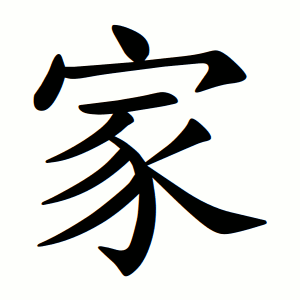家
- home;
- family;
- household;
Etymology
Traditional interpretation:
Says 宀 (house roof) gives the meaning and 豭 (수퇘지 가) — the “boar” character (later simplified as 豕) — gives the sound.
But no early inscriptions with 宀 + 豭 have been found.
Linguistic reconstruction:
Scholars believe 家 combines 宀 (roof) and 豕 (pig).
Some even suggest the earlier form 하 (⿳彑儿乂), a variant of pig with explicit genital marking, was used under 宀.
Oracle bone evidence:
Already shows 宀 + 豕 rather than 宀 + 하. Over time, 豕 became the fixed lower component.
Popular folk etymology:
Ancient Chinese supposedly kept pigs under their houses to ward off snakes, therefore “house with pigs” = home.
Usage in Korean
가구(家口) - household;
가장(家長) - head of household;
가정(家庭) - family;
가족(家族) - family;
작가(作家) - writer.
Words that derived from 家
- 가문(家門)–family; clan
- 가법(家法)–family rules
- 가운(家運)–family's luck
- 가장(家長)–head of a household
- 가정(家庭)–home; family
- 가족(家族)–family
- 건축가(建築家)–architect
- 국가(國家)–state; nation; country
- 귀갓길(歸家길)–way back home
- 대가(大家)–master; guru; expert; prestigious family; large house
- 대가족(大家族)–large family; extended family
- 도시 국가(都市國家)–city state
- 만화가(漫畫家)–cartoonist
- 사업가(事業家)–businessperson; entrepreneur
- 세계평화통일가정연합(世界平和統一家庭聯合)–Family Federation for World Peace and Unification
- 시가(媤家)–one's husband's home
- 실업가(實業家)–businessman; industrialist
- 인가(人家)–house; dwelling
- 자본가(資本家)–capitalist
- 작가(作家)–writer; author
- 화가(畫家)–painter; artist
- 활동가(活動家)–activist
